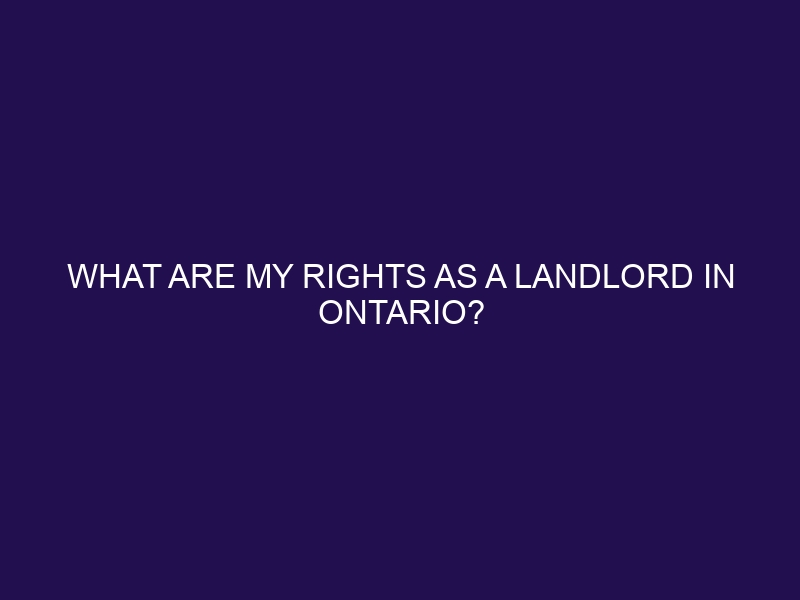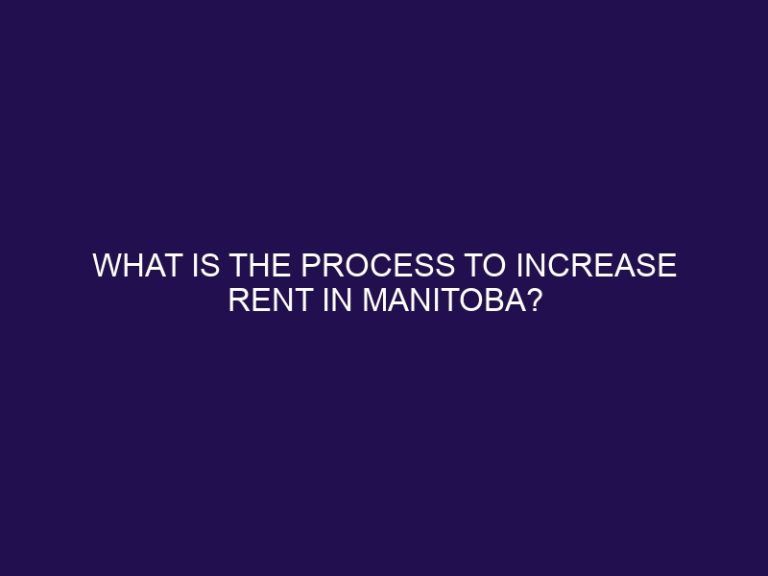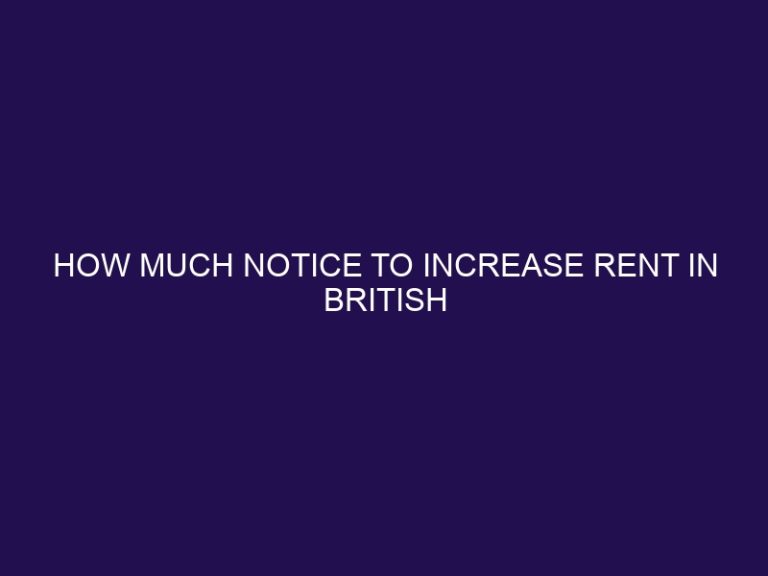What are my rights as a landlord in Ontario?
.jpg)
As a landlord in Ontario, it is crucial to understand your rights and responsibilities to ensure a smooth and legal rental process. Familiarizing yourself with the regulations and guidelines outlined by the provincial government can help protect your interests and maintain a positive landlord-tenant relationship.
Here are the key rights and responsibilities for landlords in Ontario:
1. Screening and Selecting Tenants: Landlords have the right to screen potential tenants by conducting background checks, reviewing references, and ensuring they meet specific criteria.
2. Setting and Increasing Rent: Landlords are responsible for determining the initial rent and following the guidelines set by the Rent Increase Guideline in Ontario.
3. Maintenance and Repairs: Landlords have the obligation to maintain the rental property in a safe and habitable condition, ensuring necessary repairs are promptly addressed.
4. Entry and Privacy: Landlords must provide notice to tenants before entering the rental unit, respecting their right to privacy.
5. Eviction Process: Landlords have the right to evict tenants following proper legal procedures outlined by the Residential Tenancies Act (RTA).
6. Ending Tenancy: Landlords can end a tenancy for specific reasons such as the landlord’s own use of the property or renovation purposes, following the guidelines provided by the RTA.
In addition to these rights and responsibilities, there are key considerations that landlords should be aware of in Ontario:
1. Ontario Residential Tenancies Act: Familiarize yourself with the RTA, which governs the rights and obligations of landlords and tenants in the province.
2. Landlord and Tenant Board: Understand the role of the Landlord and Tenant Board as the governing body overseeing rental disputes and providing resolutions.
3. Rental Agreement and Lease: Use a comprehensive rental agreement or lease that outlines the terms and conditions of the tenancy, protecting both parties involved.
4. Discrimination and Human Rights: Landlords must adhere to the Ontario Human Rights Code, ensuring they do not discriminate against tenants based on protected grounds such as race, gender, or disability.
5. Insurance and Liability: Landlords should consider obtaining landlord insurance to protect themselves from potential risks and liabilities associated with property damage or personal injury.
To further understand the rights and responsibilities as a landlord in Ontario, here are some frequently asked questions:
1. Can a landlord refuse to rent to someone?
2. How much can a landlord increase rent in Ontario?
3. What are the landlord’s responsibilities for repairs?
4. How much notice does a landlord need to give to enter a rental unit?
5. What is the eviction process in Ontario?
6. How can a landlord end a tenancy in Ontario?
By having a comprehensive understanding of these rights, responsibilities, and key considerations, landlords can navigate the rental process in Ontario with confidence and ensure a fair and lawful tenancy for both parties involved.
Key Takeaways:
- Screening tenants: Landlords in Ontario have the right to screen and select tenants based on established criteria to ensure responsible and reliable individuals.
- Rent control: Ontario landlords are required to follow specific rules regarding setting rent and increasing it, as outlined by the Residential Tenancies Act.
- Maintenance and repairs: Landlords in Ontario have the responsibility to maintain the rental property and address necessary repairs in compliance with legal requirements.
Rights and Responsibilities of Ontario Landlords
As an Ontario landlord, it’s crucial to understand your rights and responsibilities. In this section, we’ll dive into the nitty-gritty of your obligations and privileges, addressing key aspects such as tenant screening and selection, rent setting and increases, maintenance and repairs, privacy concerns and entry protocols, the eviction process, and ending a tenancy. Get ready to become well-versed in the rights and responsibilities that come with being a landlord in Ontario!
1. Screening and Selecting Tenants
Screening and selecting tenants is an essential step for landlords in Ontario to ensure a smooth and hassle-free tenancy. Here are the key steps to follow:
- Screening and selecting tenants: Advertise the rental property through various channels.
- Create a rental application form.
- Ask potential tenants to fill out the application, providing necessary personal and financial information.
- Verify the information provided, including employment, income, and references.
- Conduct a background and credit check on potential tenants.
- Evaluate the tenant’s suitability based on the information gathered.
- Invite qualified tenants for a property tour and interview.
- Review and discuss the lease agreement with the selected tenant.
- Collect a security deposit and complete all necessary paperwork.
- Provide the tenant with a copy of the lease agreement and other relevant documents.
For a true history example, a landlord in Ontario successfully screened and selected tenants by implementing these steps. As a result, they found reliable and responsible tenants who paid their rent on time and maintained the property in good condition throughout the tenancy.
2. Setting and Increasing Rent
Setting and increasing rent as a landlord in Ontario requires following specific steps to ensure compliance with the law and maintain a fair tenant-landlord relationship.
Here are the steps involved in setting and increasing rent in Ontario:
- Review the current market rental rates in your area.
- Determine the maximum rent increase allowed by the Residential Tenancies Act.
- Provide written notice of the rent increase to your tenants at least 90 days before it takes effect.
- Use the proper forms and templates provided by the Landlord and Tenant Board.
- Consider any exceptions or special cases that may affect the rent increase, such as rent control exemptions for newer buildings.
Fact: In Ontario, the process of setting and increasing rent involves adhering to regulations specified by the Residential Tenancies Act. Rent can only be increased once every 12 months for most residential units, and there are specific rules and calculations to determine the maximum allowable rent increase.
3. Maintenance and Repairs
- Maintenance and Repairs: Landlords are responsible for performing routine maintenance tasks, such as cleaning common areas, checking smoke detectors, and maintaining landscaping. They must promptly address repair requests from tenants, ensuring that the property remains in a safe and habitable condition.
- Emergency Repairs: Landlords need to respond immediately to emergency repair situations that affect the health, safety, or security of tenants.
- Communication: Effective communication between landlords and tenants is crucial to address maintenance and repair issues promptly.
- Documentation: Landlords should keep clear records of all maintenance and repair requests, inspections, and work performed.
Fact: According to the Ontario Residential Tenancies Act, landlords are legally obligated to maintain their rental properties and make necessary repairs to ensure the safety and well-being of their tenants.
4. Entry and Privacy
In Ontario, landlords have rights and responsibilities when it comes to entry and privacy. As per the Ontario Residential Tenancies Act, landlords are required to give notice before entering a rental unit, unless it is an emergency. Normally, landlords must provide a notice period of 24 hours and enter the premises during reasonable hours. It is important for landlords to respect the privacy of their tenants and refrain from unnecessary intrusion. Moreover, they should ensure that any entry is justified by a valid reason, such as conducting repairs or inspections. By comprehending and adhering to these regulations, landlords can maintain a respectful and lawful relationship with their tenants.
5. Eviction Process
- Eviction Process: The eviction process is a legal procedure that landlords in Ontario must follow to remove a tenant from their rental property.
- Notice of Termination: Issue a Notice of Termination: Provide written notice to the tenant stating the reason for eviction, such as non-payment of rent.
- Landlord and Tenant Board: File an Application with the Landlord and Tenant Board: Submit an application to the Board, including supporting documents and the applicable filing fee.
- Hearing: Attend the Hearing: Both the landlord and tenant will have an opportunity to present their arguments and evidence before a hearing officer.
- Eviction Order: Receive the Order: If the Board rules in favor of the landlord, an eviction order will be issued with a specified date for the tenant to vacate the premises.
- Enforce the Order: If the tenant fails to leave after the specified date, the landlord can request the assistance of the Sheriff to physically remove the tenant.
It is important for landlords to follow the eviction process correctly and comply with all legal requirements to avoid any potential issues or disputes.
6. Ending Tenancy
- Ending a tenancy: In Ontario, ending a tenancy requires following specific steps to ensure a smooth and legal process:
- Review the Residential Tenancies Act: It is important to review the Residential Tenancies Act to understand your rights and obligations as a landlord when ending a tenancy.
- Provide proper notice to the tenant: As a landlord, you are required to provide the tenant with proper notice, which usually ranges from 60 to 90 days, before ending the tenancy.
- Document the condition of the rental unit: Before the tenant moves out, it is essential to document the condition of the rental unit to avoid any disputes later on.
- Collect any outstanding rent and damages: As a landlord, you should make sure to collect any outstanding rent and damages owed by the tenant before the tenancy is terminated.
- Return the tenant’s security deposit: After deducting any necessary expenses for damages or unpaid rent, the landlord must return the tenant’s security deposit.
- Complete a thorough inspection: It is crucial to conduct a thorough inspection of the rental unit after the tenant has moved out to assess any damages or issues that need to be addressed.
In a similar tone, throughout history, landlord-tenant relationships have evolved to protect both parties’ rights and uphold the principles of fairness and accountability. These regulations ensure that landlords have clear guidelines to follow when ending a tenancy while also providing tenants with the necessary time and resources to find alternative housing.
Key Considerations for Landlords in Ontario
Being a landlord in Ontario comes with a set of key considerations that can greatly impact your experiences and obligations. In this section, we’ll dive into vital aspects that every landlord should be aware of. From the Ontario Residential Tenancies Act and the Landlord and Tenant Board to understanding rental agreements and leases, we’ll explore the essential factors that shape landlord-tenant relationships. We’ll touch on the critical subjects of discrimination and human rights, as well as insurance and liability. Buckle up for an enlightening exploration of landlord responsibilities in Ontario!
1. Ontario Residential Tenancies Act
The Ontario Residential Tenancies Act, also known as the RTA, is a vital piece of legislation that governs the rights and responsibilities of landlords in Ontario, Canada. This comprehensive act establishes the legal framework for various aspects of the landlord-tenant relationship, including but not limited to tenant screening, rent establishment and increases, property maintenance and repairs, privacy and entry regulations, the eviction process, and tenancy termination. Landlords in Ontario must make it a priority to familiarize themselves with the Ontario Residential Tenancies Act, as it is crucial for them to operate within the legal boundaries and safeguard their own rights. Understanding the provisions of this act is essential in order to steer clear of any potential legal complications or violations, which could result in penalties or disagreements with tenants.
2. Landlord and Tenant Board
The Landlord and Tenant Board is an essential entity for landlords in Ontario to familiarize themselves with. Here are the key steps to navigate the process:
- Know the legislation: Familiarize yourself with the Residential Tenancies Act.
- File an application: Submit the necessary forms to initiate a dispute or request a hearing at the Landlord and Tenant Board.
- Prepare evidence: Collect all relevant documentation to support your case, such as leases, payment records, and communication with tenants.
- Attend the hearing: Present your case, provide evidence, and respond to any questions or concerns from the Landlord and Tenant Board.
- Receive a decision: The Landlord and Tenant Board will provide a written decision outlining their ruling and any necessary actions to be taken.
Pro-tip: Familiarize yourself with the Landlord and Tenant Board’s website for helpful resources, forms, and guidance throughout the process.
3. Rental Agreement and Lease
A rental agreement and lease are crucial documents for landlords in Ontario. Here are key points to consider for incorporating a rental agreement and lease in Ontario:
- 1. Understand the Residential Tenancies Act: Familiarize yourself with the legislation that governs rental agreements in Ontario to ensure compliance and avoid legal issues.
- 2. Include essential clauses: Clearly outline the duration of the tenancy, rent amount, payment terms, and any additional rules or obligations to protect both parties.
- 3. Properly screen tenants: Conduct background checks and reference checks to ensure that prospective tenants are reliable and trustworthy.
- 4. Keep the rental agreement and lease updated: Review and update the rental agreement and lease periodically to reflect any changes in rent, rules, or other terms agreed upon by both parties.
- 5. Seek legal advice if needed: If you have any concerns or questions regarding the rental agreement or lease, consult with a legal professional for guidance.
Fun Fact: The Residential Tenancies Act in Ontario protects the rights of both landlords and tenants, fostering a fair and balanced rental market.
4. Discrimination and Human Rights
In Ontario, landlords must abide by anti-discrimination laws and respect tenants’ human rights. They cannot refuse to rent to someone based on protected grounds such as race, gender, religion, or disability. Landlords must treat all potential and current tenants equally and provide reasonable accommodations for individuals with disabilities. It is important for landlords to familiarize themselves with the Ontario Human Rights Code to ensure they are complying with the law. Discrimination and human rights, which are crucial considerations for landlords in Ontario, play a vital role in ensuring fair and equal treatment of all individuals seeking rental accommodations.
5. Insurance and Liability
As a landlord in Ontario, understanding the importance of insurance and liability is crucial. The right insurance coverage protects you from potential risks and legal issues. When it comes to insurance options for landlords, property insurance, liability insurance, and rental income protection are typically included.
Property insurance is designed to cover damages to the property itself, while liability insurance provides coverage for injuries or damages that may occur on your property. Additionally, rental income protection insurance helps cover lost income in the event that your property becomes uninhabitable due to an insured incident.
To ensure you have the appropriate coverage for your specific needs, it is recommended to consult an insurance professional who is familiar with landlord insurance. Don’t forget to regularly review and update your insurance policy to ensure you have adequate coverage for any changes to your property or rental activities.
1. Can a landlord refuse to rent to someone?
Yes, a landlord in Ontario can refuse to rent to someone, but they must have a valid reason that falls within the specified grounds outlined in the Ontario Human Rights Code. It is important to note that it is illegal for a landlord to discriminate against a potential tenant based on protected grounds such as race, religion, disability, or gender. However, landlords can exercise their right to refuse to rent to someone if they believe that the tenant will not be a good fit for the property. For example, if the tenant has a history of damaging rental units or not paying rent. Therefore, it is crucial for landlords to familiarize themselves with the human rights laws to ensure that they are treating all potential tenants fairly.
Pro-tip: To avoid any potential discrimination claims, it is always advisable for responsible landlords to document their reasons for refusing to rent to someone.
2. How much can a landlord increase rent in Ontario?
In Ontario, landlords can increase rent once every 12 months for most residential rental units. The maximum allowable increase is determined by the provincial government and is based on the annual Rent Increase Guideline. For 2023, the Rent Increase Guideline is set at 1.2%. There are exceptions to this guideline for certain types of rental units, such as those in newer buildings or those subject to a variety of government programs. It is important for landlords to familiarize themselves with the specific rules and regulations regarding rent increases in Ontario to ensure compliance and avoid any legal issues.
To answer the question, in Ontario, landlords can increase rent once every 12 months. The maximum allowable increase is determined by the provincial government, which follows the annual Rent Increase Guideline. For 2023, the Rent Increase Guideline is set at 1.2%. However, there are exceptions for certain types of rental units. Landlords must be aware of the specific rules and regulations related to rent increases in Ontario to ensure they comply with them and avoid any potential legal problems.
3. What are the landlord’s responsibilities for repairs?
In Ontario, landlords have specific responsibilities when it comes to repairs in rental units. These responsibilities include maintaining the property’s structure, ensuring it is safe and habitable, and making necessary repairs to the plumbing, heating, and electrical systems. Landlords must also address issues related to pests and maintain common areas. It is important for landlords to respond promptly to repair requests and to keep a record of all repairs and maintenance done on the property. Failure to fulfill these responsibilities can result in legal consequences. Remember, being proactive and addressing repairs in a timely manner can help maintain a positive landlord-tenant relationship.
The landlord’s responsibilities for repairs include maintaining the property’s structure, ensuring it is safe and habitable, making necessary repairs to the plumbing, heating, and electrical systems, addressing issues related to pests, and maintaining common areas. It is crucial for landlords to respond promptly to repair requests and document all repairs and maintenance carried out on the property. Failure to meet these responsibilities can lead to legal consequences. Remember, taking a proactive approach and promptly addressing repairs can contribute to a positive landlord-tenant relationship.
4. How much notice does a landlord need to give to enter a rental unit?
The landlord in Ontario must provide proper notice before entering a rental unit. According to the Residential Tenancies Act, the notice period is defined as 24 hours. The landlord should give notice in writing, specifying the reason for entry and the proposed date and time. There are exceptions in cases of emergency or if the tenant agrees to shorter notice. It is important for landlords to respect their tenants’ privacy and follow the legal requirements for entry.
To answer the question, “How much notice does a landlord need to give to enter a rental unit?”, in Ontario, the landlord is required to give 24 hours’ notice before entering a rental unit. This notice should be provided in writing and should clearly state the reason for entry as well as the date and time of proposed entry. It is crucial for landlords to adhere to these notice requirements and respect their tenants’ privacy. In cases of emergency or if the tenant agrees to shorter notice, exceptions can be made.
I have a personal anecdote related to this topic. A friend of mine once rented a unit in Ontario and had a wonderful relationship with his landlord. The landlord consistently provided ample notice whenever he needed to enter the rental unit for inspections or repairs. This high level of respect and consideration from the landlord made my friend feel appreciated as a tenant and contributed to a positive renting experience.
5. What is the eviction process in Ontario?
The eviction process in Ontario involves several steps that landlords must follow to legally remove a tenant from a property. What is the eviction process in Ontario? Let’s break it down:
- Serve the tenant with a Notice of Termination, specifying the reason for eviction and the date by which the tenant must leave.
- If the tenant does not voluntarily vacate the property by the specified date, file an application with the Landlord and Tenant Board.
- Attend a hearing at the Landlord and Tenant Board to present evidence supporting the eviction.
- If the Board grants an eviction order, provide a written notice to the tenant stating the date and time they must leave the property.
- If the tenant fails to comply with the eviction order, hire a sheriff to carry out the eviction.
6. How can a landlord end a tenancy in Ontario?
In Ontario, landlords have specific procedures to follow when ending a tenancy. Here are the steps to end a tenancy in Ontario:
- Provide written notice to the tenant, stating the reason for termination.
- Give the appropriate notice period based on the reason for termination (e.g., 60 days for landlord’s own use, 90 days for substantial renovations).
- Make sure the notice is properly served to the tenant.
- File an application with the Landlord and Tenant Board if the tenant does not move out by the specified date.
- Attend the hearing and present the case to the Board.
- If the Board grants an eviction order, arrange for the sheriff to enforce it and regain possession of the rental unit.
Remember to follow the guidelines outlined in the Residential Tenancies Act and seek legal advice if needed. It is essential to understand your rights and responsibilities as a landlord in Ontario to ensure a smooth and lawful termination process.
6. How can a landlord end a tenancy in Ontario?
Some Facts About Landlord Rights in Ontario:
- ✅ Landlords must ensure that rental units and property meet health, safety, and housing standards. (Source: Legal Line)
- ✅ Landlords have the right to select tenants based on income, credit checks, references, and rental history. (Source: Legal Line)
- ✅ Landlords can collect rent, enter the premises for repairs and maintenance, show the unit to potential tenants, and in emergencies. (Source: Legal Line)
- ✅ Landlords can increase rent up to the annual limit set by the government and evict tenants for lease breaches or violations of the Act. (Source: Legal Line)
- ✅ Amendments to the RTA effective September 1, 2021, allow landlords to apply for orders requiring tenants to pay expenses due to conduct that interferes with the landlord’s enjoyment or rights. (Source: Legal Line)
Frequently Asked Questions
What are my rights as a landlord in Ontario?
As a landlord in Ontario, you have several rights outlined by the Residential Tenancies Act (RTA) and Ontario law. Here are some key rights:
Can I select tenants based on income information and credit references?
Yes, landlords in Ontario have the right to select tenants based on income information, credit checks, rental history, and references.
What are my rights regarding rent collection?
As a landlord, you have the right to collect rent from your tenants. Rent must be paid in full on the due date, and landlords must provide receipts upon request.
Am I allowed to enter the premises as a landlord?
Yes, as a landlord, you have the right to enter the rental unit for repairs and maintenance, to show the unit to potential tenants, and in emergencies. However, you must provide notice to the tenant before entering, except in emergency situations.
What can I do if a tenant breaches the lease agreement?
If a tenant breaches the lease agreement, you have the right to evict them. You can file an application with the Landlord and Tenant Board (LTB) to pursue the eviction process.
What are my rights in terms of maintaining housing standards?
As a landlord, you are obligated to ensure that rental units and property meet health, safety, and housing standards. Failure to do so can result in investigations and charges.
What legal actions can I take if a tenant fails to pay rent or damages the property?
If a tenant fails to pay rent, damages the property, or breaches their lease, you can file applications with the LTB to seek rent arrears, compensation, or eviction. The LTB can provide further information and assistance in such situations.







